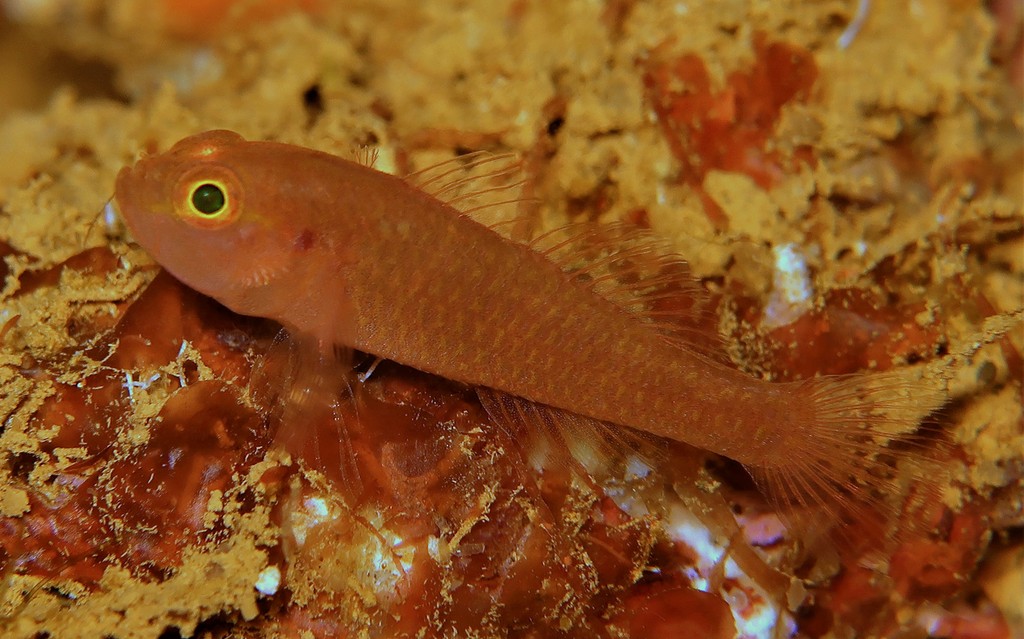TRIMMA STOBBSI - (WINTERBOTTOM, 2001)
Picture courtesy of: Alain Daoulas
Actinopterygii (Gigaclass) > Actinopteri (Class) > Teleostei (Subclass) > Gobiiformes (Order) > Gobioidei (Suborder) > Gobiidae (Family) > Gobiinae (Subfamily) > Trimma (Genus)
Stobb's dwarfgoby, Stobbs' pygmygoby,
Description
Dorsal spines (total): 7; Dorsal soft rays (total): 9-10; Anal spine: 1; Anal soft rays: 8-9 (usually: 9); Pectoral fin rays: 16-19 (usually: 18); Pelvic fin rays: 1 + 5; Longitudinal scales: 22-24 (usually: 24). Second dorsal soft spine not elongate or occasionally slightly elongate, reaching posteriorly to the base of the spine or first ray of the second dorsal fin when depressed. First ray of the second dorsal fin may be branched or unbranched, all remaining rays branched. Pectoral rays reaching posteriorly to a vertical through the base of the first anal fin ray or just anterior to this. A variable number of uppermost and lowermost rays unbranched with branched rays in between. Pelvic fins no frenum, basal membrane vestigial, first four rays with a single sequential branch, fifth ray unbranched (one dichotomous branch on one side in three specimens), 50-70% of the length of the fourth ray; the fourth ray reaching posteriorly to the first to fifth elements of the anal fin. No predorsal scales, posterior half of the nape with a slightly developed longitudinal ridge in the midline, scales present on either side of the ridge with a very narrow scaleless gap between them; slight interorbital trench which extends posteriorly barely beyond mid pupil, no postorbital trench. Max. length: 2.5 cm TL. Depth range: 1 - 40 m.
Color
Distinct round to oval spot (vivid red to dark red-brown) above and just anterior to posterodorsal corner of opercle. Head yellow, with brown chromatophores, yellow pigment extending around eyes and along sides of head just beyond opercular spot. Tinges of pink on opercle (probably from gill filaments) and pectoral base. Body ranging from light yellowish-brown to dull grey brown, with color extending anteriorly to behind pectoral-fin base and along nape just posterior to eye. Scale pockets faintly outlined with brown chromatophores. Dorsal fins with brown chromatophores, a yellow stripe just above base. Specimen from Flores with yellow head and body appears to be bright salmon pink, although brown chromatophores present.
Etymology
Trimma: from Greek, trimma, -atos = something crushed.
stobbsi: Named for Robin E. Stobbs, friend, guru, and colleague, whose expertise in so many things was instrumental in launching my career (especially the fieldwork aspects) all those years ago at the JLB Smith Institute of Ichthyology in Grahamstown, South Africa.
Original description: Trimma stobbsi Winterbottom, 2001 - Type locality: New Caledonia, Port de Goro, West of concrete lighthouse,
22°20’00”S, 167°00’20”E, R. Winterbottom, G. Klassen and P. Tirard, 3 Sept. 1991.
Distribution
Indo-West Pacific: Maldives east to Philippines, Indonesia, Vietnam, Papua New Guinea and Solomon Islands, south to Ashmore Reef (Western Australia), Queensland (Australia), New Caledonia and Vanuatu.
Biology
Solitary or in small groups in caves and ledges. Also found in steep seaward slopes.
Actinopterygii (Gigaclass) > Actinopteri (Class) > Teleostei (Subclass) > Gobiiformes (Order) > Gobioidei (Suborder) > Gobiidae (Family) > Gobiinae (Subfamily) > Trimma (Genus)
Stobb's dwarfgoby, Stobbs' pygmygoby,
Description
Dorsal spines (total): 7; Dorsal soft rays (total): 9-10; Anal spine: 1; Anal soft rays: 8-9 (usually: 9); Pectoral fin rays: 16-19 (usually: 18); Pelvic fin rays: 1 + 5; Longitudinal scales: 22-24 (usually: 24). Second dorsal soft spine not elongate or occasionally slightly elongate, reaching posteriorly to the base of the spine or first ray of the second dorsal fin when depressed. First ray of the second dorsal fin may be branched or unbranched, all remaining rays branched. Pectoral rays reaching posteriorly to a vertical through the base of the first anal fin ray or just anterior to this. A variable number of uppermost and lowermost rays unbranched with branched rays in between. Pelvic fins no frenum, basal membrane vestigial, first four rays with a single sequential branch, fifth ray unbranched (one dichotomous branch on one side in three specimens), 50-70% of the length of the fourth ray; the fourth ray reaching posteriorly to the first to fifth elements of the anal fin. No predorsal scales, posterior half of the nape with a slightly developed longitudinal ridge in the midline, scales present on either side of the ridge with a very narrow scaleless gap between them; slight interorbital trench which extends posteriorly barely beyond mid pupil, no postorbital trench. Max. length: 2.5 cm TL. Depth range: 1 - 40 m.
Color
Distinct round to oval spot (vivid red to dark red-brown) above and just anterior to posterodorsal corner of opercle. Head yellow, with brown chromatophores, yellow pigment extending around eyes and along sides of head just beyond opercular spot. Tinges of pink on opercle (probably from gill filaments) and pectoral base. Body ranging from light yellowish-brown to dull grey brown, with color extending anteriorly to behind pectoral-fin base and along nape just posterior to eye. Scale pockets faintly outlined with brown chromatophores. Dorsal fins with brown chromatophores, a yellow stripe just above base. Specimen from Flores with yellow head and body appears to be bright salmon pink, although brown chromatophores present.
Etymology
Trimma: from Greek, trimma, -atos = something crushed.
stobbsi: Named for Robin E. Stobbs, friend, guru, and colleague, whose expertise in so many things was instrumental in launching my career (especially the fieldwork aspects) all those years ago at the JLB Smith Institute of Ichthyology in Grahamstown, South Africa.
Original description: Trimma stobbsi Winterbottom, 2001 - Type locality: New Caledonia, Port de Goro, West of concrete lighthouse,
22°20’00”S, 167°00’20”E, R. Winterbottom, G. Klassen and P. Tirard, 3 Sept. 1991.
Distribution
Indo-West Pacific: Maldives east to Philippines, Indonesia, Vietnam, Papua New Guinea and Solomon Islands, south to Ashmore Reef (Western Australia), Queensland (Australia), New Caledonia and Vanuatu.
Biology
Solitary or in small groups in caves and ledges. Also found in steep seaward slopes.
